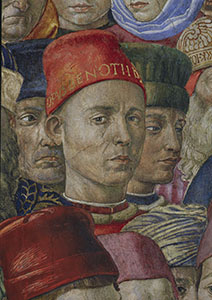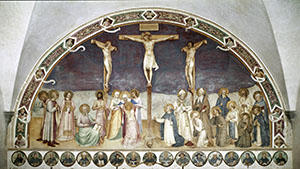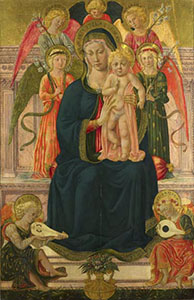
Self-portrait by Benozzo Gozzoli, Chapel of the Magi, Florence.

Crucifixion, Museum of San Marco, Florence.

Madonna and Child with Angels, National Gallery, London.
Benozzo was born in Florence, probably in 1420 or 1421, in a house in Via del Fiore, in the Santo Spirito quarter. In 1427, by order of the Brancacci family, the great church of the nearby Convent of the Carmine was decorated by Masaccio with a cycle of frescoes. This work revolutionised art in Florence and undoubtedly influenced the young Benozzo's development.
Spending time in the countryside near the Florentine hills in the Settimo area must also have helped to shape his professional development. Indeed, in that area, from which his family originated (and still maintained family ties and property), Benozzo certainly had the opportunity to refine his skills of observation, which would become a distinguishing feature of his artistic production, as noted by Giorgio Vasari in his 1568 book, Lives of the Most Eminent Italian Painters, Sculptors and Architects (
Vite
de' pił eccellenti architetti, pittori, et scultori italiani), in which he describes Benozzo as "very rich in invention, and very productive in the painting of animals, perspectives, landscapes and ornaments".
Benozzo's father sent him to an artist's studio for an apprenticeship, probably no earlier than 1435 if he is assumed to have attended 'primary school' and then a "scuola dell'abaco", a school for further study of writing and administrative competencies useful for those pursuing the professions of merchant or independent artisan. This hypothesis as to the painter's schooling is not proven by any documentation but is based, firstly, on the custom of the time according to which the sons of sufficiently well-to-do artisans would receive this kind of education and, secondly, on Gozzoli's command of writing, demonstrated by the autograph documents and the many inscriptions that appear on his paintings, written in "ancient-style" characters and with correct use of the Latin Language.
Vasari's theory that Benozzo was a pupil of Fra Angelico (the Angelic Friar), also known as "il Beato Angelico" (the Blessed Angelic One), is not widely accepted by critics, partly because it would have been impossible for Fra Angelico (Angelic Friar), who was first and foremost a Dominican monk, to run a full-blown artist's studio from his monastery attended by lay apprentices. Neither has it yet been ascertained that Benozzo attended the studio of the miniaturist Zanobi Strozzi, the greatest of Fra Angelico's (the Angelic Friar) disciples, who he could have met later on while collaborating on the decoration of the Convent of San Marco (Saint Mark).
At that time, there were many studios in Florence, mainly located on what is now Via dei Calzaiuoli and the adjacent streets and in the area behind the Cathedral. Since it is impossible to determine with any certainty where Benozzo did his apprenticeship, it has been hypothesised that he probably attended the studio of an artist based not far from his own home, perhaps Bicci di Lorenzo, a master painter who ran one of the most active studios in Florence and a member of the confraternity of Sant'Agnese in the Convent of the Carmine, together with his son, Neri, a contemporary of Benozzo's.
We do know that, in October 1439, Benozzo participated in the creation of the beautiful funeral pall (the cloth used during the solemn coffin display ceremony) commissioned by that very confraternity. Indeed, documentation from that period identifies Benozzo as one of the painters of the work, although it is impossible to say with any certainty whether he was yet a master in his own right enrolled in the Arts (medieval corporations formed to organize economic activities).
Benozzo's development and personal style are documented from the early works he painted independently, such as the Madonna and Child with Angels in the National Gallery in London. This piece includes precious brocaded fabrics, revealing one of his specific qualities, namely his meticulousness in the painting of precious fabrics, making them appear almost real. It is highly probable that this ability to illustrate and differentiate between different fabrics came from his father, a tailor, who would undoubtedly have educated Benozzo in this tradition from an early age, giving him the opportunity to observe and admire textile products close up.
His participation in the frescoing of the Convent of San Marco (Saint Mark) in 1439-1440 and 1443-1444, an extensive and challenging project masterfully led by "il Beato Angelico" (the Blessed Angelic One), is now certain. Critics increasingly agree that this was a work of collaboration rather than that of a master and his disciples.
Having completed the work at the Convent of San Marco (Saint Mark), Benozzo went to work, in partnership with Lorenzo Ghiberti, on the second door of the Baptistery, known as the "Gate of Paradise". The contract between these two artists is dated 1st March 1444, and the wage paid to Benozzo was considerable in the first year and increased during the next two (their collaboration is believed to have ended in 1447). During this assignment, Benozzo had the opportunity to refine his perspective illustration skills. Based on stylistic similarities with other paintings of his, several of the scenes on the Gate of Paradise are attributed to him, particularly in the last two panels depicting the Stories of Saul and David and the Visit of the Queen of Sheba to King Solomon.
Serena Nocentini